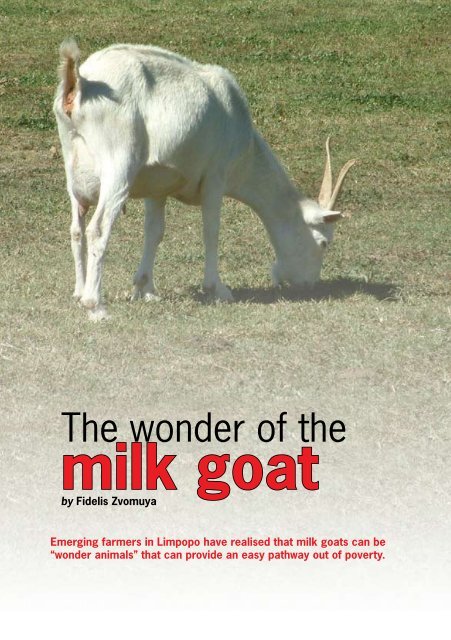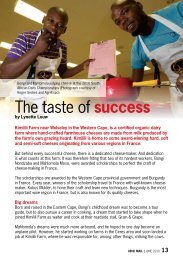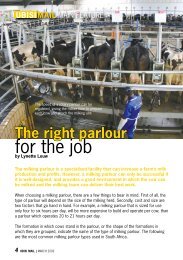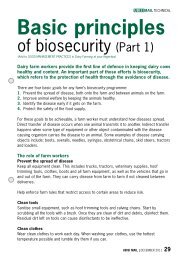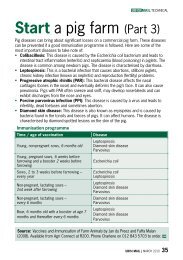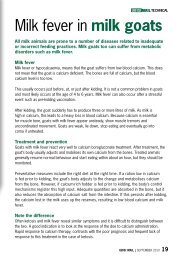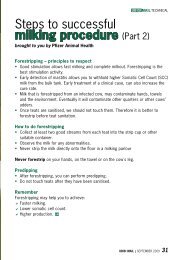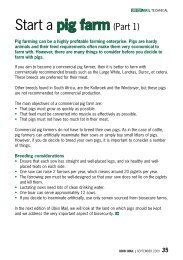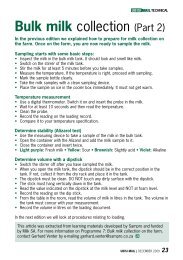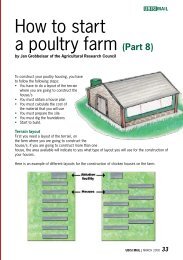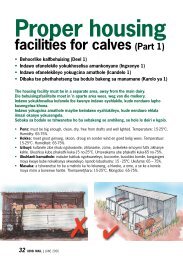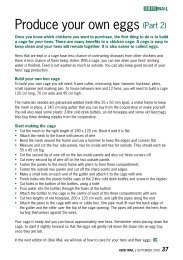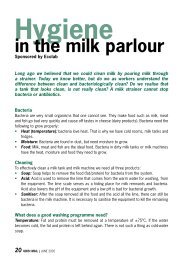You also want an ePaper? Increase the reach of your titles
YUMPU automatically turns print PDFs into web optimized ePapers that Google loves.
The wonder of the<strong>milk</strong> <strong>goat</strong>by Fidelis ZvomuyaEmerging farmers in Limpopo have realised that <strong>milk</strong> <strong>goat</strong>s can be“wonder animals” that can provide an easy pathway out of poverty.12 UBISI MAIL | MARCH 2009
EMPOWERMENTAccording to Francina Moloto of Makibelo Village in Limpopo, <strong>milk</strong> <strong>goat</strong>s can be kept ona marginal piece of land and reproduce very quickly. This means that farmers can buildup a herd in no time and get a return on their investment soon.Francina is a member of the Gpopeng Makibelo Dairy Goat Project. The 36 femalefarmers who are members of the project, are supported by the international nongovernmentalorganisation, Heifer International.Opportunities from <strong>milk</strong> <strong>goat</strong>sMoloto says that these animals have changed the lives of the project’s members. Theanimals handle easily, are easy to transport, are not expensive to buy and to feed, andare easy to house. The changes have been so big, that many more people want to jointhe project.“Dairy <strong>goat</strong> farming offers opportunities for profitable and sustainable diversification onour small farms, especially in the past when our maize crop was affected by drought,”she says.The farmers use the <strong>goat</strong> manure to fertilise their gardens. The <strong>milk</strong> is used to feedtheir families and some is sold. The money from the <strong>goat</strong>s’ <strong>milk</strong> is used to buy farminputs and to send their children to school.Moloto says that dairy <strong>goat</strong>s are not a specialised enterprise, and easily became anintegral part of their mixed farming activities: “Goats can be kept on a small piece ofland. They need a well-constructed house, with a good roof and a raised floor. The floorshould have slats that allow droppings and other dirt to fall through and allow air tocirculate and keep the animals dry.”Heifer InternationalThe female farmers were introduced to dairy <strong>goat</strong>s in 2005. Heifer Internationaldonated 12 <strong>goat</strong>s to 12 farmers and taught them about production techniques, animalmanagement and <strong>milk</strong> handling.The number of participants has increased to 36 through the organisation’s “Passing onthe Gift” concept. This concept means that a family which receives a <strong>goat</strong>, must givethe first female offspring of that <strong>goat</strong> to the next family. They must also teach the nextfamily to care for the <strong>goat</strong>.Heifer International Limpopo manager, Johannes Maledi, says that before the initiativewas launched, the farmers were farming with only maize and other crop production thatrequire expensive inputs such as fertiliser.Potential to growMaledi says that <strong>goat</strong>s are cheaper to rear, have a high <strong>milk</strong> yield and are less labourintensive. “It is our hope that if more farmers join the project, then we will be ableUBISI MAIL | MARCH 2009 13
EMPOWERMENTto switch from raw <strong>milk</strong> sales to value addition. This means that we will create morecompetition,” he says.Maledi believes that the growing market for dairy products shows great potential forvalue-added products such as yoghurt, fermented <strong>milk</strong>, whipped cream and cheese, butregulations and high costs mean that it is not an easy road to take.The <strong>goat</strong>s kept by the farmers are mainly cross-breeds between the so-called “exotictemperate” and the indigenous breeds.Learning about <strong>goat</strong>sHeifer International used unit level training as the basis from which they trained andtaught the farmers about best practises, how to ensure quality during <strong>milk</strong>ing, feedingtheir <strong>goat</strong>s in a way that would guarantee maximum <strong>milk</strong> yield, common diseasesthat may affect <strong>goat</strong> <strong>milk</strong> productivity, the administration of drugs and <strong>milk</strong> withdrawalperiods (when the <strong>goat</strong> gives less <strong>milk</strong>) after treatment.Training was also given in fodder development and conservation. Farmers werealso taught how to recognise good genes and improve genotype. In this sense theywere trained in judging and inspection, breeding improvement, <strong>goat</strong> production andmanagement, as well as record-keeping.“Once our <strong>milk</strong> production is high enough, we hope to add value to the <strong>milk</strong>, so that wecan increase the shelf life and get even better prices for our <strong>milk</strong>,” says Moloto. UMDairy <strong>goat</strong>s can be kept on a small piece of land and in well-constructed housingUBISI MAIL | MARCH 2009 15


